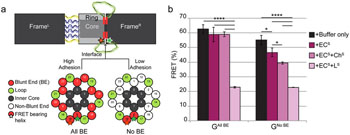Novel Programmable DNA Nanosystem Designed for Low Cost Molecular Detection
By LabMedica International staff writers
Posted on 05 Jul 2016
Based in a novel way on the self-assembly forces between DNA complementary strands, researcher have developed programmable nanosystem that has now been applied in a proof-of-principle study on Ebola virus diagnosis potential.Posted on 05 Jul 2016
The nanomachine is based on “the magic of how DNA works,” said Erik R. Henderson, professor, Iowa State University (Ames, IO, USA). Prof. Henderson and former student Dr. Divita Mathur developed the system and its first application: genetic detection of Ebola virus. Such a machine would prove valuable in the developing world, where access to diagnostic medical equipment can be rare. This nanotechnology could be fabricated cheaply and deployed easily. In conjunction with a smartphone app, it could be used independently of traditional medical facilities to detect Ebola or other pathogens and diseases.

Image: Base stacking adhesive forces versus OPTIMuS actuators. (a) The interface makeup between the ring and frameR shown as a cross-section of OPTIMuS. It can be modified with coaxial blunt ends (BE) to create high adhesion or no blunt ends to minimize adhesion. (b) FRET output of all blunt ends (All BE) versus no blunt ends (No BE) OPTIMuS upon the addition of different force domains (****Indicates P ≤ 0.0001; *Indicates P ≤ 0.05) (Photo courtesy of Scientific Reports).
The trick lies in understanding the rules that govern how DNA works, said Prof. Henderson, “It’s possible to exploit that rule set in a way that creates advantages for medicine and biotechnology.” The researchers harnessed DNA hybridization forces so that the components of the nanomachines, once added to water and then heated and cooled, find each other and assemble correctly without further effort from the individual deploying the machines.
More technically, they harnessed the difference in persistence length (“rigidity”) of single-stranded and double-stranded DNA to elicit a defined physical state change in a self-assembling DNA nanosystem, a platform they call OPTIMuS (Oligo-Propelled Technology for Interrogating Molecular Systems). This inducible state change can be used to interrogate user-programmed molecular interactions within OPTIMuS. In this study they showed how OPTIMuS can be used to detect a soluble target molecule and assess the relative strength of a non-covalent (base stacking) molecular interaction. They employed an embedded photonic system that tests for the presence of the target molecules, where upon detection the photonic system flashes a light, which can be read with a fluorometer.
This sort of technology could be modified to detect other pathogens and other kinds of molecules. Prof. Henderson also envisions development of similar nanomachines that would encapsulate medication for targeted delivery.
The study, by Mathur D & Henderson ER, was published online June 7, 2016, in the journal Scientific Reports.
Related Links:
Iowa State University













